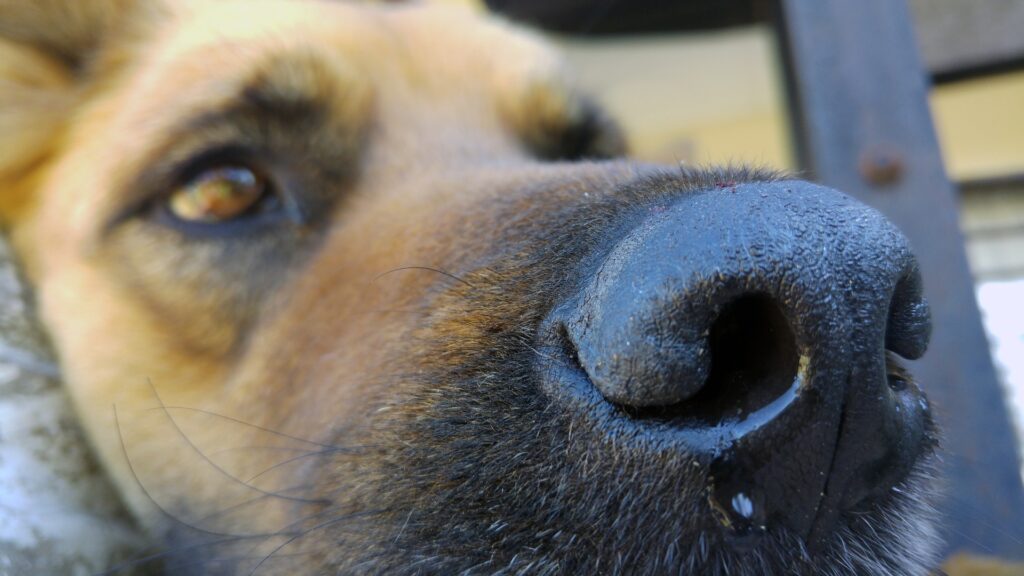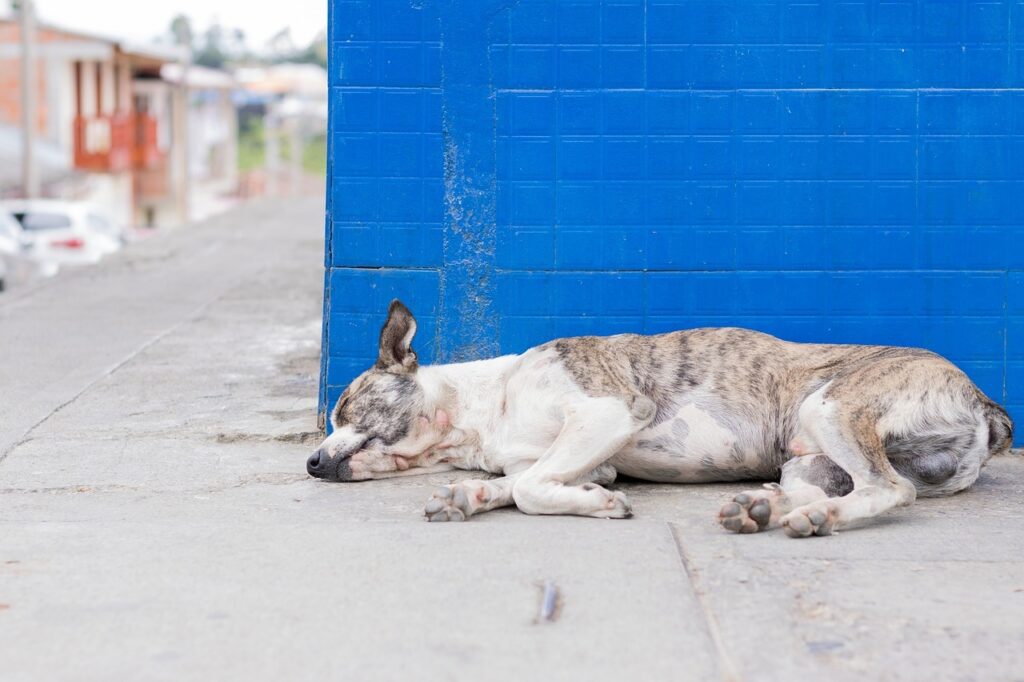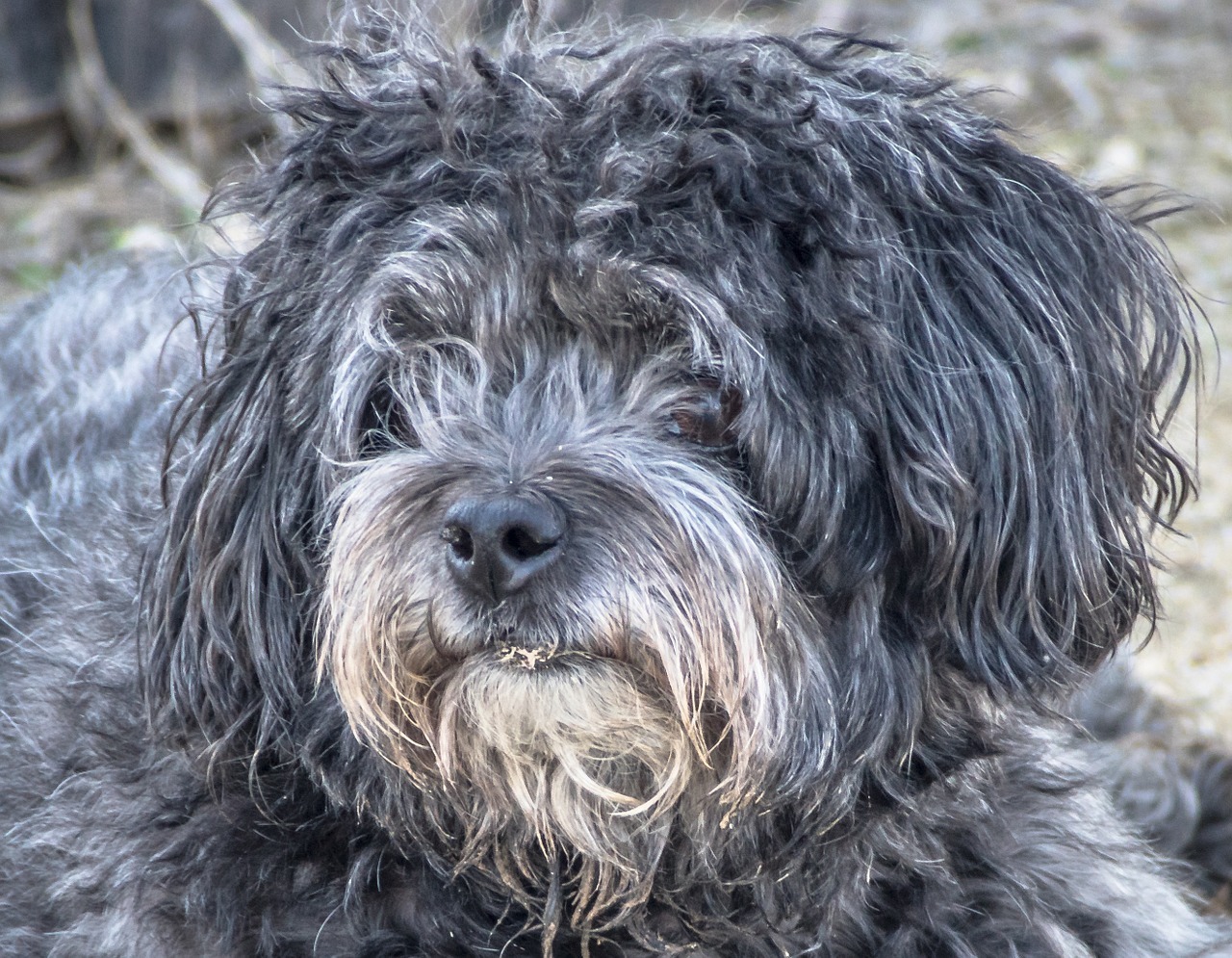Is your dog constantly itching, biting, or scratching recently?
Well, there are chances that he may have an allergy.
Food allergies affect about 0.2% of dogs worldwide according to the State of Pet Health Report released by Banfield Hospital.
If you have given him medications and changed your grooming habits but the problem doesn’t seem to go away, your mutt probably has a food allergy.
- What is food allergy?
- Causes of Food Allergies in Dogs
- Common Allergens
- Most Common Symptoms of Food Allergies in Dogs
- Is It Food Allergy or Intolerance?
- How do you tell that your dog has a food allergy (and not flea or environmental allergy)?
- What Should You Give A Dog With Food Allergies?
- 5 Simple Homemade Dog Food Recipes for Dogs with Allergies
- Preventing Food Allergies
- Related Questions
- Bottom-line
What is food allergy?
Food allergy occurs when the dog’s immune system misidentifies an ingredient (mostly a protein) as an invader (rather than a good food ingredient) and launches an immune response.
This over-response may result in itchy skin or skin infections in some dogs as well as vomiting and diarrhea in others.
Some dogs will have both skin and gastrointestinal problems.
I know the above definition might be a bit confusing given that some dogs are allergic to grains, fats, and some vegetables.
Well, you should understand that most of the foods that your dog consumes contain protein.
While most people only recognize meat as the main source of protein, it is important to understand that proteins are also present in grains and vegetables.
So, any of these ingredients have the potential to cause food allergy in dogs.
Causes of Food Allergies in Dogs
So, why are some more allergic to certain foods than others? What can cause a dog to develop an allergy?
Well, while animal experts understand that food allergies result from an overreaction of a dog’s immune system, it is not clear why some dogs tend to be more vulnerable than others.
Some researchers believe that genetic anomaly plays a significant role. In other words, it is something that your dog is born with.
Environmental factors have also been cited by a bigger percentage of researchers.
It is believed that food allergies also occur as a result of what a dog is fed or exposed to.
Both hypotheses are correct.
To begin with, the genetic argument is supported by the fact that some dog breeds and bloodlines seem to be more prone to food allergies than others.
Secondly, dogs from similar regions or environmental conditions have been shown to exhibit similar food allergy patterns, which supports the environmental hypothesis.
There are factors that are believed to cause food allergies in dogs but these two are most prominent.
But one thing that all researchers seem to support is the fact that allergies occur when dogs are exposed to certain allergens.
Common Allergens
BMC Veterinary Research published a study in 2016 on common dog food allergens.
The study indicated that dogs are likely to be allergic to the following food ingredients.
- Chicken
- Dairy Products
- Beef
- Wheat
- Yeast
- Soy
- Corn
And here is how much a reaction the allergens may have on dogs

Source: Dogsee Chew
It is essential to avoid using the above ingredients when making dog food recipes for allergic dogs.
You can choose alternative sources of proteins like salmon and lamb.
We’ll cover more about this in the subsequent sections.
Most Common Symptoms of Food Allergies in Dogs

All types of allergic reactions, irrespective of the cause, are often visible on your dog’s skin.
The most common symptom is itching though there are a host of other signs that you be aware of, including:
- Sneezing
- Sneezing
- Skin rashes
- Scaly or oily skin
- Itchy paws
- Hair loss
- Eye discharge
- Red eyes
- Pigmented skin
- Leathery skin texture
- Vomiting
- Diarrhea (with or without mucus or blood in stool)
- Abdominal pain
- Straining while passing stool
Your dog may also suffer from the following symptoms. Although they are not as common as the ones listed above, they are likely to occur in some dogs:
- Breathing difficulties
- Nasal discharge
- Urinary tract infections
- Seizures
- Weight loss (especially in combination with vomiting or diarrhea)
Behavioral symptoms are rarer but are likely to occur due to discomfort from the above-highlighted symptoms. So, you may also see the following:
- Restlessness
- Frequent scratching and shaking of ears
- Frequent scratching of the skin on furniture or people
- Moodiness and reduced interest in play
- Biting of tail and paws
- Anorexia
Is It Food Allergy or Intolerance?
The above-highlighted symptoms can also be caused by other issues such as viruses, parasites, pancreatitis, bacterial infections or eating something that the dog shouldn’t.
If your dog shows the above symptoms only after eating certain foods, it could be a food allergy.
But it could also be intolerance—the food may contain too much fat, little or too much fiber or have other ingredients that don’t agree well with your dog.
Let’s dig deeper…
When a dog has a food allergy, his immune system is misidentifying the food that he has eaten as a harmful ingredient.
As a result, the body creates defensive antibodies to combat and protect it from foreign food items/invaders.
On the other hand, food intolerance has very little to do with the immune system of the dog.
It is more of a digestive problem. It occurs when a dog has trouble digesting certain ingredients in his food like lactose.
When your dog has lactose intolerance, therefore, it means that his digestive system cannot break down lactose, causing digestion stress and ultimately making him sick.
So, how do you distinguish between the symptoms of the two cases?
Well, food intolerance is often associated with digestive distress, including bloating, gas, vomiting, diarrhea, and nausea while food allergy tends to cause skin rashes, itching, obsessive licking of skin and paw biting. Most allergy symptoms are related to the skin.
Although skin conditions are the most prevalent issue with allergies, some food allergies may also cause digestive upset.
So, if you aren’t sure, consult your vet for more professional input.
How do you tell that your dog has a food allergy (and not flea or environmental allergy)?

Well, the first thing to check is the nature of the symptoms. Here are the telltale signs that your dog may have food allergy (and not an environmentally-caused allergy)
- Your dog is still young—typically, puppies of less than 1 year don’t experience allergies
- The symptoms aren’t related to seasonal changes or climatic conditions (for instance, you don’t see any change when you travel with your dog from a humid area to a dry area).
- Your dog experiences both skin and gastrointestinal symptoms
- The allergy doesn’t respond to antihistamines and supplements for itchy skin
Next, consult a veterinarian. Only a professional will help you figure out whether your pooch’s symptoms are due to food allergy.
Once you are sure that it is a food allergy, the next step is to identify the responsible allergens.
Most vets recommend the use of elimination diets as the best method for identifying the ingredients that may be causing allergies in your dog.
For starters, an elimination diet entails switching to a different protein and carbohydrate sources—something that your dog isn’t used to.
For instance, you could switch from chicken to sweet potato or lamb.
If your dog responds better, it implies that your dog may be allergic to chicken and you can switch to chicken-free foods.
What Should You Give A Dog With Food Allergies?
Once you have established that your dog has a food allergy, how do you feed him? Which types of food should you give him?
The secret is giving him food sources that don’t contain the ingredients (or allergens) for which he exhibits allergic reactions.
In other words, the best diet for a dog with allergy-related to a food item is a diet that doesn’t include the food.
If your dog has grain allergies, for instance, give him grain-free diets. And if he’s allergic to wheat, you can use a substitute ingredient like rice flour.
Here are the most common food formulations for dogs with food allergies:
A. Limited Ingredient Foods
These contain only one protein source such as lamb or chicken and may also include one source of carbohydrates.
The goal of limited ingredient foods is to make it easier for dog owners to narrow down to specific ingredients when it comes to identifying the type of foods that may be causing allergic reactions to their dogs.
B. Grain-free Foods
As the name suggests, these are formulated for dogs with sensitivities to grains like wheat, corn, rye, or barley.
Most grain-free foods are gluten-free. However, you should note that not all grains contain gluten.
So, not all gluten-free dog foods are necessarily grain-free.
C. Novel Ingredients
Are diets that are centered on protein sources that a dog has not been exposed to.
Instead of common sources of proteins like beef and chicken, novel ingredients are often focused on less-common sources like salmon or duck.
Limited ingredient foods may also contain novel proteins.
D. Prescription Dog Foods
Are mostly recommended and obtained from veterinarians.
Most vets will recommend a few dietary changes besides prescription dog foods.
E. Hypoallergenic Foods:
Are mostly limited ingredient foods found in pet food stores.
F. Hydrolyzed Diets
These are diets that break up carbohydrates and protein molecules into smaller sizes to prevent them from triggering any form of allergic reaction in your dog.
Now, the best foods for dogs with food allergies should be any of the above-highlighted formulations—most of them are formulated to avoid common allergens.
Another option for feeding dogs with allergies is making your own dog food.
With a homemade recipe, you get to avoid triggers because you decide what ingredients go into your dog’s diet.
Although it is time-consuming and might require some trial and error to figure out what’s working, it can do wonders for your dog’s itchy skin and digestive issues.
5 Simple Homemade Dog Food Recipes for Dogs with Allergies

After your vet has established the allergen(s) that may be responsible for the allergy, you simply need to create homemade dog food that excludes all the allergen(s) but balanced nutritionally.
The best way to go about this is by using suitable substitutions for your dog meal.
As aforementioned, for dogs that are allergic to wheat, you can use a substitute ingredient like rice flour.
And for dogs that are allergic to chicken or beef, turkey can be a suitable substitute.
Here are simple recipes that you can try. Choose the best option based on what allergens your vet has identified.
1. Recipe #1: Beef Stew (Best for dogs with chicken allergies)
Ingredients:
- ½ kg of beef stew meat
- 1 sweet potato
- ½ cup of flour
- ½ cup of green beans, diced
- ½ cup of carrots, diced
- 1/2 cup of water
- 1 tbsp olive oil
Preparation:
- Cook the sweet potato in a microwave for about 6 minutes until it is tender but firm
- Cut the beef stew into small pieces
- Heat the olive oil in a skillet over medium heat and add the meat. Allow it to cook for 10-15 minutes. Meanwhile, dice the sweet potato.
- Separate drippings from the meat. Add water and flour to the drippings as you whisk and heat over medium heat until it creates a thick gravy.
- Add the meat, veggies, and potatoes and stir to coat. Cook for 15 minutes.
- Allow it cool before serving.
2. Recipe #2: Turkey, Rice & Mixed Veggies Meal
Ingredients:
- 1.5kg ground turkey
- 1 ½ cups brown rice
- 3 cups chopped baby spinach
- ½ cup of peas(canned or frozen)
- 2 carrots
- 1 zucchini
- 1 tablespoon olive oil
Preparation:
- Steam the brown rice
- Heat the olive oil in a separate large pot over medium heat.
- Add the turkey and stir. Allow it to cook until brown, and make sure you crumble it as it cooks.
- Add the veggies plus the rice and allow it to cook for about 5 minutes
- Once ready, allow it to cool before serving.
3. Recipe #3: Easy Crockpot Dog Food
Ingredients:
- ½ cup of frozen peas
- ½ cups butternut chopped squash
- 1 ½ cups uncooked brown rice
- 1 ½ cups chopped carrots
- 1 can of kidney beans (15 oz)
- water, 4 Cups
- 1.2kg ground turkey
Preparation:
- Put all the ingredients in a crockpot and add 4 cups of water
- Cover the crockpot and allow to cook for about 6 hours in medium or 3 hours in high heat. Stir often as it cooks.
- Cool to room temperature before serving
4. Recipe #4: Doggie Chili
Ingredients:
- 4 chicken breasts
- 1 cup of drained black beans
- 1/2 cup of tomato paste
- 1 cup of diced carrots
- 1 cup of kidney beans, drained
- 3 cups of chicken broth
Preparation:
- Dice the chicken breasts into small nickel-shaped pieces. Be sure to remove any excess fat
- In a skillet, cook the diced chicken over medium heat until the pink color disappears
- Once cooked add all ingredients in a large pot and cook over medium heat for about 10 minutes
- Allow it to cool before serving
5. Recipe #5: Lamb Mixed With Rice
Ingredients:
- 3 lbs (raw weight), cooked lamb.
- 4 1/2 lbs rice should be prepared with sunflower oil
- 1/2 cup Homemade Dog Food Vitamins
Preparation:
- In a large pot, put the ground lamb and add water enough to cover before you heat.
- When it starts to boil cover and allow it to simmer for some 30 minutes until the lamb is well cooked.
- Drain the excess water.
- Allow it to cool.
- Mix the cooked lamb with the cooked rice and the Homemade Dog Food Vitamins and serve.
Preventing Food Allergies

Are there ways that you can leverage to avoid food allergies in dogs?
Well, there is no straight answer to this question as there’s no known way of preventing food allergies entirely.
Nonetheless, there are a few things that you can do to help your dog fight different types of allergies:
A. Control Gastroenteritis
Some dog health experts believe that early cases of gastroenteritis in puppies might result in adult dogs that are prone to food allergies.
Accordingly, try to control or treat the condition immediately you notice it in your dog.
Discourage your dog from anything that’s not food or treats. In reality, this can be hard. Check out for tips here.
If you suspect that your dog has eaten something that may cause stomach upset, give him a low-protein diet till the upset passes, or consult your local vet for the best course of action.
B. Give your dog foods with exclusive protein sources
Foods with one or two protein sources will give you more choices in case your dog develops an allergy.
On the flip side, if your dog develops an allergy and he is used to multiple protein sources, finding foods that don’t contain all the protein sources can be quite daunting.
C. Focus more on foods that can promote efficient protein digestion
The food you give to your dog shouldn’t bring him digestion issues. So, if you are giving him a raw diet, blending or grinding the food can help improve digestion.
F. Ensure that your dog gets a balanced diet and proper healthcare
Related Questions
1. What’s the difference between human and dog allergies?
Both causes of symptoms of allergies in dogs are more or less the same as those in humans.
The only difference is the fact that human beings tend to have better thermal regulatory systems.
2. Are some dog breeds more prone to food allergies than others?
Food allergies can affect any dog breed. However, there are certain breeds that seem to suffer more than others. The breeds include:
- Retrievers
- Dalmatian
- Cocker Spaniel
- Maltese
- Standard Poodles
- Boxer
- German shepherd
- Chinese Shar-peis
- Schnauzers
- Dachshund
- Doberman Pinschers
- White terrier
- Cocker spaniel
- Lhasa Apso
- Bichon Frise
- Brussels Griffon etc
3. Are there over-the-counter medications for dog allergies?
Yes, there are antihistamines and supplements that can minimize itching. Most of them are safe and vet-approved for home use.
There are also anti-itch ointments and shampoos. Before using any OTC remedies, consult your vet.
4. Can antibiotics administered early in a dog’s life cause allergy?
Well, some experts believe that a dog who received antibiotics at an early age may be prone to food allergies because the drugs change their digestive systems.
Antibiotics are believed to kill beneficial bacteria in the dog’s systems that are responsible for good immune functions in dogs.
Most vets recommend probiotic supplements for this kind of allergy.
However, it is important to note that this treatment has not been well investigated in dogs and the human-based researches that have been carried out on the subject have produced mixed results.
5. Can raw foods help with allergies?
While it is true that some raw protein sources have slightly different structural configurations with cooked options, and may go a long way in preventing them from triggering unnecessary allergic reactions, no scientific evidence supports such deductions.
If anything, raw diets have several drawbacks that tend to limit their overall appeal.
For instance, raw meat has been shown to harbor a wide range of bacteria, including E. coli, Salmonella spp. and Clostridium spp.
Parting Thoughts
Dealing with food allergies in dogs can be daunting and disheartening.
Proper diagnosis is the best way to figure out the allergens so that appropriate measures can be taken, especially with regard to feeding your dog the right types of foods.
Hopefully, the above tips have shown some light on what you can do.
Take heart, things will get better for your canine friend.
Related Posts:
45 Simple Remedies for Dry and Itchy Skin in Dogs
12 Best Probiotic for Dogs with Allergies
Protein Allergy in Dogs: What Every New Dog Parent Must Know
As an Amazon Associate, we may receive a small commission from qualifying purchases but at no extra cost to you. Learn more. Amazon and the Amazon logo are trademarks of Amazon.com, Inc, or its affiliates.

